I note that there is a new engine patent that has just been published with Dan Gurney, resident of Santa Ana ,named as the inventor.
The patent is US2017/0009649, filed June 23rd 2016 with the title "Moment-Cancelling 4-Stroke Engine Systems", and it discloses a relatively novel engine.
https://patents.google.com/patent/US20170009649A1/en
As shown, it is a two cylinder piston engine, but in typical patentese it is presented in as broad a form as possible so that is encompasses 2, 4, 6, 8, 10, and 12 cylinder versions. It is clearly a quite highly tuned engine for competition purposes, and again is presented as being suitable for motorcycles, cars, trucks, boats, and aircraft. The patent goes into some very detailed specifics of various features such as gas exchange valving, seats, and port geometry and the effect on power. There are 21 figures included.
The novel aspect of the engine is that there are two geared and contra-rotating crankshafts, and the two-cylinder version illustrated in the patent certainly looks like it may have been designed for a motorcycle. However, the two independent claims (the most important ones) as drafted do not sound very novel at all to me because all of the features with the one exception of fuel injection (which of course all modern engines have) are to be found in the 1931 Ariel Square Four engine, of which this engine appears to be half. The second independent claim adds that the engine can be supercharged, but of course the Neander motorcycle engine has the double crankshaft arrangement and is boosted. There are several other features of the engine covered in the dependent claims, such as the cranks are de saxe to the bores which may not be true of the Ariel or Neander engines and thus this could be added to the independent claims to make the patent stronger. It is an interesting patent, well worth a read.
PJGD

Dan Gurney's New Engine (A V12 it is Not)
#1

Posted 05 November 2017 - 02:23
Advertisement
#2

Posted 05 November 2017 - 07:54
The Neander is de saxe with the crankshafts mirrored ether side of the bore axis. I read recently that Yanmar will begin marketing a diesel Neander outboard engine. I think it will be Yanmar branded. Sounds like a major success for Neander.
#3

Posted 05 November 2017 - 21:39
Yes, the Neander is unusual in having a Rhombic drive; in effect half of Dr. Lanchester's 1895 flat twin.
I recall that FEV had an outboard version of the Neander engine on their display at the 2014 SAE Congress in Detroit, so no doubt they were heavily involved in development of the Yanmar version.
PJGD
#4

Posted 06 November 2017 - 05:27
Hello all.
Here is the Lanchester twin crank:
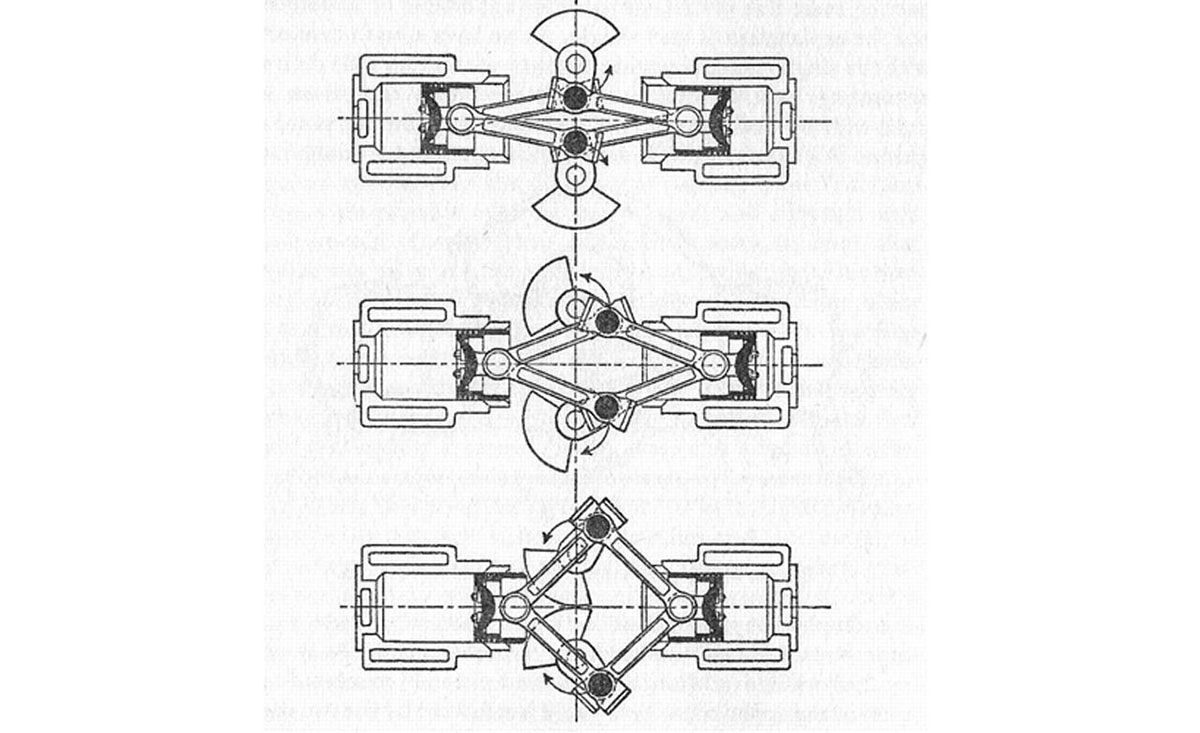
Here is one version of the Achates Power twin-crank Opposed Piston:
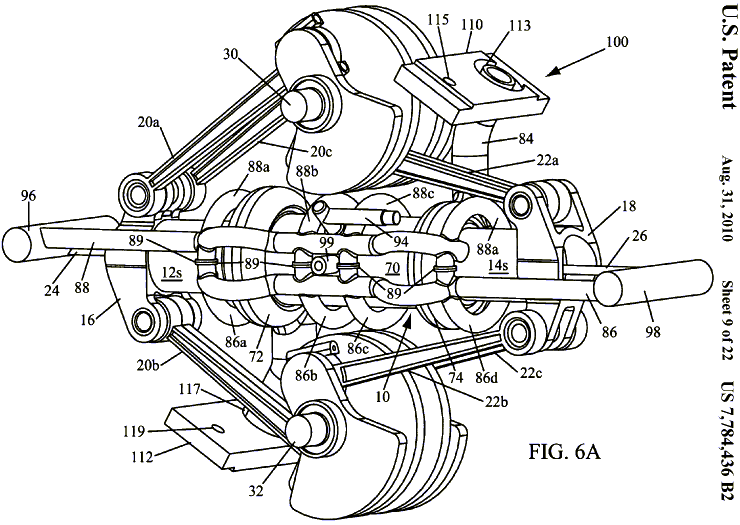
Here is the Neander twin crank:
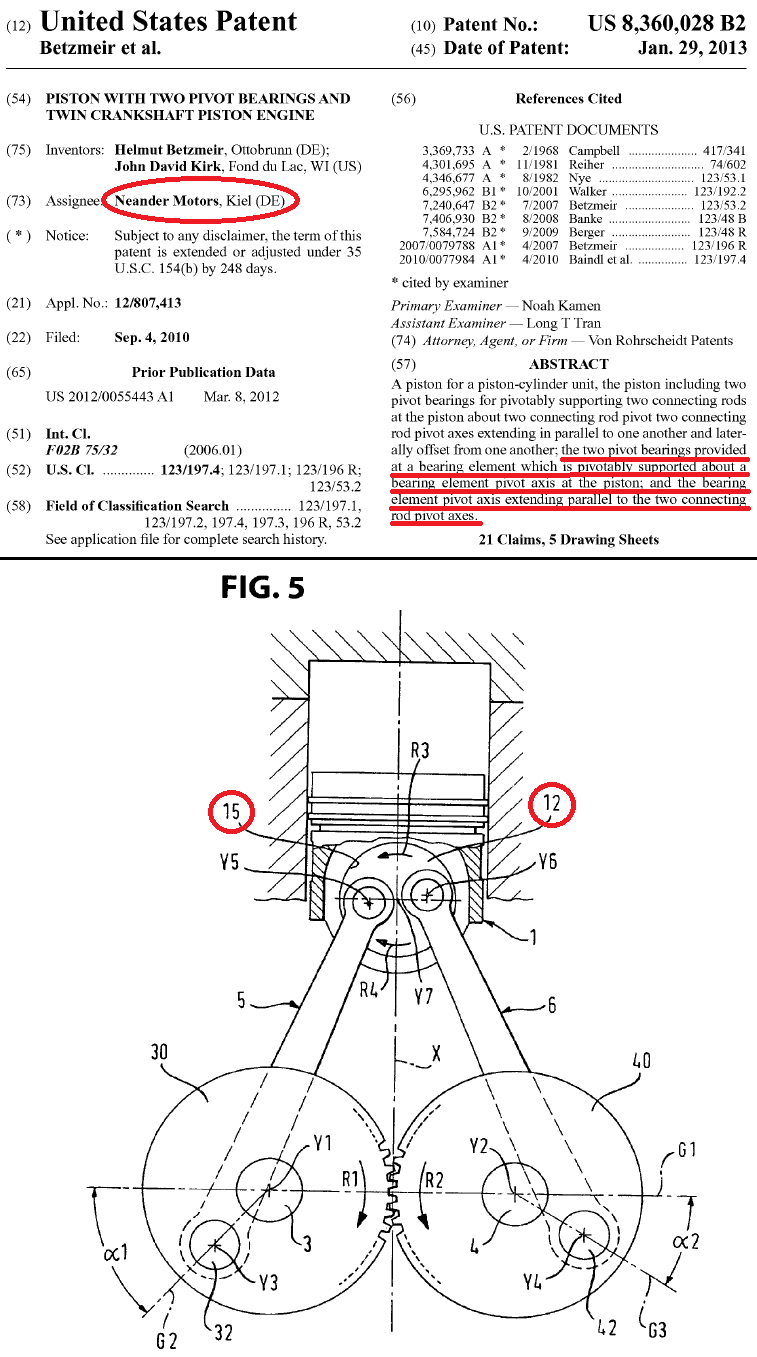
According the abstract (and the claims), the Neander engine is characterized by an intermediate pivot 12 / 15 (actually a big diameter piston pin pivoting about an axis Y7 of the piston) whereon the small ends of the two connecting rods are pivotally mounted (pivot axes Y5 and Y6 on the big diameter piston pin 12 / 15) at a significant offset from each other.
For the rest, while the balancing of the inertia forces of the Lanchester twin crank is (or can be) perfect, the balancing of the inertia forces of the Neander regards only the first order inertia forces.
The absence of side loads between the cylinder liner and the piston skirt of the Neander engine reduces the friction loss, while the added crankshaft / bearings / gearing increases the friction.
In comparison, here is another, more unconventional “twin crank” engine, the OPRE tilting:
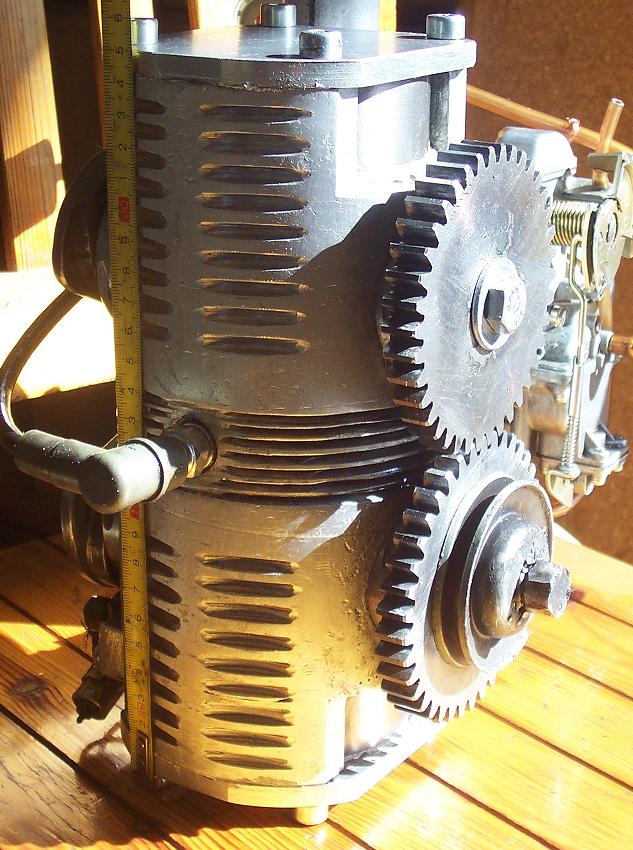
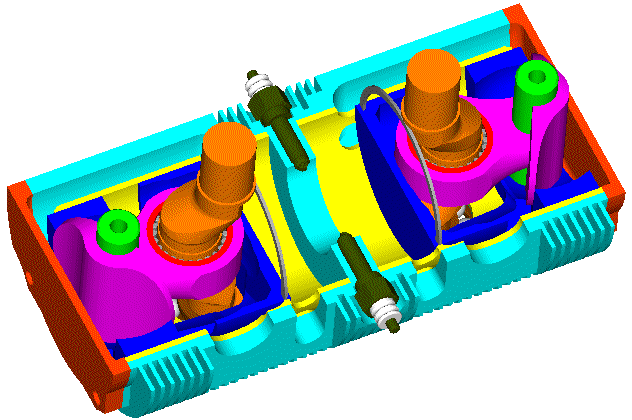
wherein the two pistons share the same combustion chamber,
and here is another OPRE standing free on the ground, burning Diesel fuel (compression ignition, 17:1 compression ratio) and driving (Diesel fuel) two counter-rotating propellers:
Spot on its vibration free quality.
The Diesel / compression ignition fits better with the 2-strokes (direct injection of the fuel at the end of the compression, no fuel-loss in the exhaust, substantially less FMEP), provided the lubrication is good (low specific lube consumption).
The OPRE 2-stroke has the additional advantage of the substantially extended piston dwell around the TDC: by providing more time to the fuel to get prepared and burnt the combustion improves and the engine can run on Diesel at significantly higher revs (more power).
Hello PJGD
The US2017/0009649 is not a patent; it is a patent application.
A couple of year ago it was granted to Gurney the US9,103,277 patent which started as a twin crank tandem engine and during the examination were limited to merely some dimensional and design improvements of the already known from the art “twin crank tandem”.
The US2017/0009649 patent application of Gurney (which is currently under Search / Examination) is, according the US Examiner, anticipated by the US9,103,277 of Gurney. . .
Thanks
Manolis Pattakos
#5

Posted 07 November 2017 - 00:33
Manolis,
You are quite right; I should have been more precise!
On the topic of "crank within the piston" type engines, you may be interested in the single crank non-OPE that is disclosed in NL9000464.
PJGD
#6

Posted 08 November 2017 - 07:28
Hello PJDG
Long before the Dutch NL9000464A (1990), the “crank within the piston” was disclosed in a US patent for a steam engine:
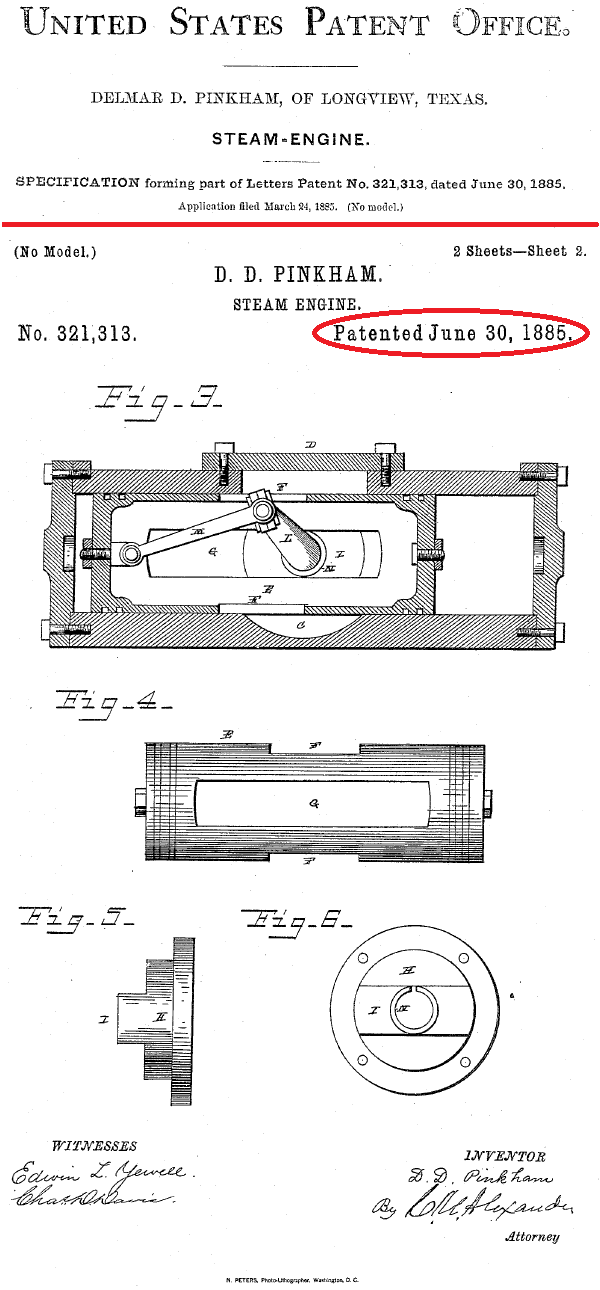
Here is the Pulling Piston Engine ( more at http://www.pattakon....pattakonPPE.htm, US6,062.187 patent):
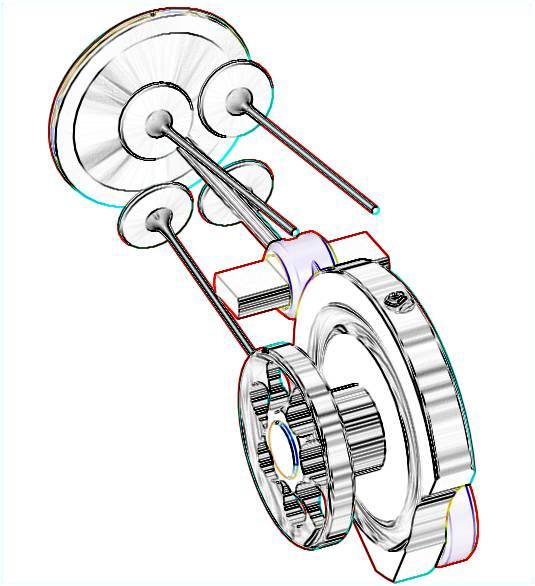
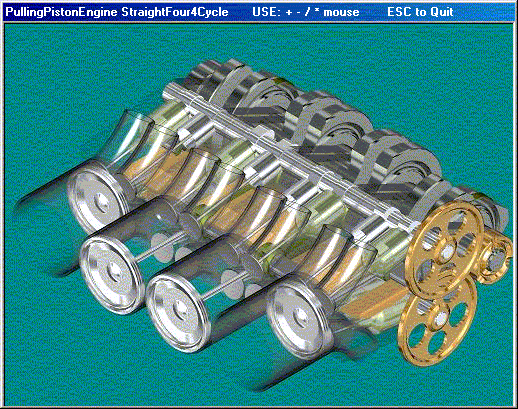
The main drawback ot the Pulling Piston Engine: the piston-rod is within the combustion chamber (this piston-rod connects the piston with its wrist pin).
From the Pulling Piston Engine it was derived, a few years later, the PRE / OPRE idea (Pulling Rod Engine):

That fulfills the same purpose: extended piston dwel at the combustion top dead center.
We had a controversy with the US-PTO patent examiner about the difference in the piston dwell at the two dead centers (BDC and TDC).
Quote from the USPTO examination report for the PRE / OPRE:
“The examiner disagrees that there is a difference between a “pulling rod engine” and a conventional engine in the dwell time piston at top dead center if the connecting rod and crankshaft arms are the same length.
This is a trigonometric certainty”
(at http://www.pattakon.com/pre/Dwell.pdf is a part of the reply to the Examiner).
It seems that the thermodynamics at the fast dead center is quite different than in the slow dead center.
To shift the combustion to the long dwell dead center is significant, especially for the compression ignition engines wherein the "ignition delay" is a dominant limitation.
Listen to the following OPRE Diesel engine:
and compare with the conventional Diesels.
As 2-stroke, the OPRE has a big advantage in power density (almost double).
As a higher revving Diesel (because it can burn at the same efficiently the fuel at some 30% higher revs), the overall power per litter of capacity is some 2.5 times higher
And the overall power per weight is even more as compared to the 4-stroke diesels like the Neander, with the OPRE having perfect balancing (vibration free quality) while the Neander design can cancel out the first order inertia forces at the cost of stronger second order . . .
Thanks
Manolis Pattakos
Edited by manolis, 08 November 2017 - 07:33.
#7

Posted 10 November 2017 - 15:28
Hello all.
The Neander engine (previous posts, FEV, Yanmar etc) has a strange power transmission:
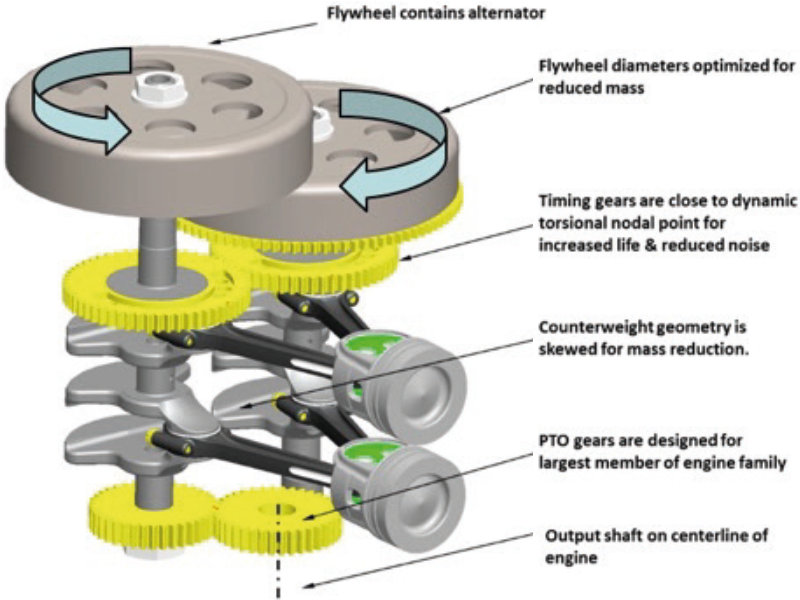
According the above drawing, the power provided by the pistons to the right crankshaft is transmitted initially to the top end of the left crankshaft (by means of the two yellow “timing” gearwheels), then (by means of another pair of gearwheels) it passes from the lower end of the left crankshaft to a drive shaft (not shown; its rotation axis is the dash-dot line) that drives (through bevel gears) the propeller.
I.e. the power provided by the pistons to the right crankshaft uses a 3-step-transmission (1:1, 1:1 and 2.07:1) till the propeller, while the power provided by the pistons to the left crankshaft uses a 2-step-transmission (1:1 and 2.07:1).
From the optimum BSFC (252gr/kWh) of the Neander Dtorque111:
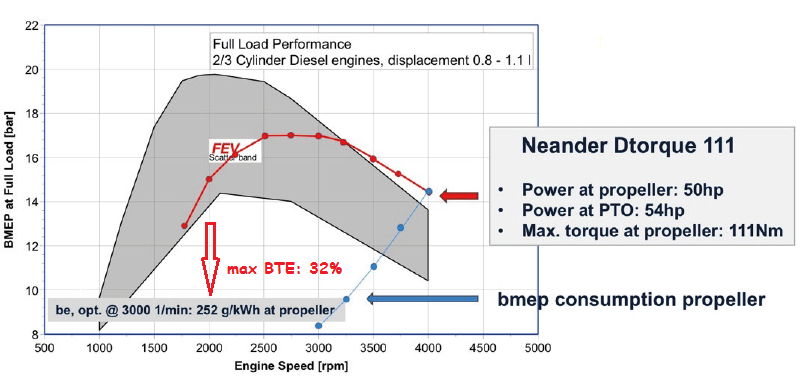
the peak BTE (measured at the propeller) is calculated at 32%.
Quote from Neander_aachen-brochure-2017-print-1.pdf:
“The specific fuel consumption shows only average for a Diesel engine, but one should not forget that outboard engines in general are rated at the propeller behind the driveline with its losses which with small transmissions can be up to 8%.”
End of Quote
Supposing 8% power loss in the “multistep” transmission of the Neander Dtorque111 outboard engine (3 “steps” for the 50% of the power and 2 “steps” for the other 50% of the power; one can call it: a 2.5 “steps” transmission), the 32% peak BTE efficiency at the propeller becomes 35% peak BTE at the crankshafts, which is still not good for a modern Diesel engine, especially one advertized as cancelling the thrust loads -and the friction loss- between the piston skirt and the cylinder liner.
For comparison, the peak BTE of the spark ignition Toyota PRIUS engine (Atkinson – Miller cycle / overexpansion) is 40%.
The cancelation of the inertia vibrations (actually of a part of the inertia vibrations, because the 2nd order inertia force remains unbalanced and strong; stronger than in a similar conventional twin because the reciprocating masses are heavier) cannot justify all this trouble (double crankshafts, triple piston pins, synchronizing gearing etc).
And from the peak BSFC / BTE (252gr/kWh, 32% at the propeller) it seems that the different architecture of the Neander engine is not improving, but is spoiling in a degree the fuel efficiency and the “mileage”.
Do I miss something?
Thanks
Manolis Pattakos
#8

Posted 14 November 2017 - 11:59
Solutions in search of a problem but fascinating nonetheless.












